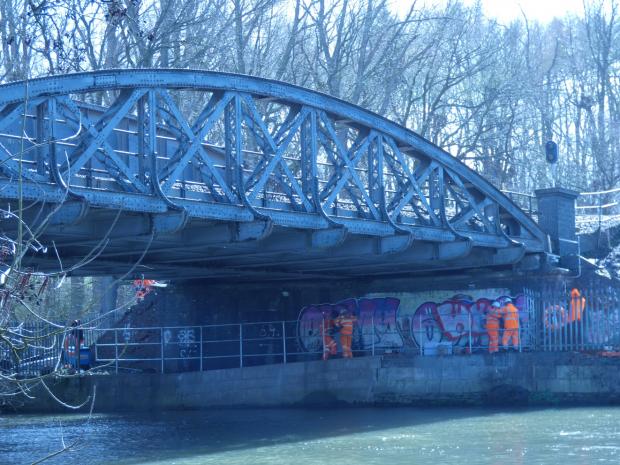|
Mark A
|
 |
« Reply #60 on: April 06, 2023, 22:39:46 » |
|
It will be interesting to know more about the date of construction of that abutment, how it failed - and why it failed now. Perhaps the structure of the abutment dates largely from the line's original construction - 1843. A photo carried by Wikimedia shows that it was showing signs of distress in 2018.  Since then there's been the continuation of the odd flood, and last year, unusual heat followed by unusual spells of cold weather - and as the structure moved, the track ballast added to the span produced an additional wedge shaped mass that increasingly loaded the abutment. (It's been remarked that the railway has a bit of a blind spot when it comes to ballast depths on structures generally, though this is a special case...) In any case, this doesn't appear to be vertical subsidence - if the abutment is rotating as its foot moves in the direction of the river, whatever force that propels that rotation will increasingly be helped along by the mass of the bridge bearing on the abutment from above. Speaking of bearings, there's then the issue that as well as being wrung by being potentially twisted, if that span has only sliding bearings that do not allow for rotation, those may be at risk of damage too, and at both ends of the span. Mark |
|
|
|
|
 Logged
Logged
|
|
|
|
|
1st fan
|
 |
« Reply #61 on: April 06, 2023, 23:18:35 » |
|
BBC» South Today showed a couple of photographs from the bridge. There was also a quote that an engineer could get his arm into the cracks.
Engineers really will put their arms into anything. |
|
|
|
|
 Logged
Logged
|
|
|
|
|
stuving
|
 |
« Reply #62 on: April 07, 2023, 00:15:03 » |
|
In this piece from the Oxford Mail on Tuesday, the story is by now familiar... The bridge was closed throughout yesterday (April 3) due to emergency repairs to a bridge. Safety concerns were raised after monitoring equipment detected increasingly significant movements of the Nuneham Viaduct, which crosses the River Thames between Culham and Radley. This is despite Network Rail doing stabilising works in recent weeks. Detailed inspections of the bridge are now underway. David Davidson, Network Rail’s interim Western route director, said: “We are sorry for the disruption this has caused for passengers and advise them to continue to check before they travel. “Safety is our top priority and our engineers our now working round the clock to identify what can be done to make this viaduct safe for passenger and freight trains to run again. “We are disappointed that the work we’ve done so far hasn’t been successful and our efforts haven’t been helped by the wettest March in over 30 years. “We will continue to provide updates as we work to reopen the line as quickly and as safely as possible.”  ... but the picture from that angle shows some new elements. You can only see the top of the wing wall on the right, which has come away, but on the left you can see how badly cracked that one is lower down. Also, the river wall has been sinking, though more so on the left, and it has cracked. This is another foreshortened view, making angles and depths hard to judge. For example, that signal is actually beyond the far track, and more than one bridge span from the end of the bridge. |
|
|
|
|
 Logged
Logged
|
|
|
|
|
TaplowGreen
|
 |
« Reply #63 on: April 07, 2023, 08:03:22 » |
|
Here are a couple of pictures of the damage - that's some serious structural damage by the looks of it!
I note this update too - Due to urgent repairs to a bridge between Didcot Parkway and Oxford the line is closed. Disruption is expected until the end of the day on 30/04/23.
|
|
|
|
|
 Logged
Logged
|
|
|
|
|
Electric train
|
 |
« Reply #64 on: April 07, 2023, 08:27:03 » |
|
Looks to me that it had the 1909 bridge support, the blue engineering bricks, built on top of the original 1843 brickwork. It looks like at some stage in the past its had a concrete added as foundation repair. The Victorian engineers did use wooden piles to build structures on, wonder if this is the case here the wooden piles have failed
|
|
|
|
|
 Logged
Logged
|
Starship just experienced what we call a rapid unscheduled disassembly, or a RUD, during ascent,”
|
|
|
|
ellendune
|
 |
« Reply #65 on: April 07, 2023, 08:37:12 » |
|
Looks to me that it had the 1909 bridge support, the blue engineering bricks, built on top of the original 1843 brickwork. It looks like at some stage in the past its had a concrete added as foundation repair. The Victorian engineers did use wooden piles to build structures on, wonder if this is the case here the wooden piles have failed
It does look like pile failure. I am not sure how they are going to repair that in two or three weeks. a temporary support in the river doesn't look easy. Perhaps new piles on either side of the abutment and a beam between? Whatever it looks like it needs an entirely new support. |
|
|
|
|
 Logged
Logged
|
|
|
|
|
Richard Fairhurst
|
 |
« Reply #66 on: April 07, 2023, 09:36:32 » |
|
Very interesting aspiration being voiced locally that the permanent bridge should have an extra deck for walking and cycling: https://twitter.com/LeyNathan/status/1644006919328219137Together with the new road bridge being built over the Thames, that would make a north-south traffic-free cycle route of some 40 miles, from Witney, Woodstock and Hanborough, via Oxford, to Culham, Didcot and Wantage. Perhaps Oxfordshire County Council should start thinking now about oozegonnapayforit... |
|
|
|
|
 Logged
Logged
|
|
|
|
|
Gordon the Blue Engine
|
 |
« Reply #67 on: April 07, 2023, 10:03:20 » |
|
Whitchurch Bridge, which is a 44 tonnes metal decked road bridge over the Thames at Pangbourne, was reconstructed in 2014. At the design stage it was established that the south abutment wasn’t strong enough, so a new abutment was constructed. The geology and quality of the chalk was an issue, which may or may not be the same at Nuneham, but 3 X 900mm piles were required, sunk to a depth of 21 metres.
If new piles are required for a conventional abutment at Nuneham then the bridge deck will need to be removed to give clear vertical space for the drilling rig. But maybe clever NR» bridge engineers have another way of installing a new abutment, eg drilling piles either side of the bridge deck and then casting a beam between them, as Ellendune suggests.
Edit to insert "metal decked".
|
|
|
|
« Last Edit: April 07, 2023, 15:40:59 by Gordon the Blue Engine »
|
 Logged
Logged
|
|
|
|
|
Mark A
|
 |
« Reply #68 on: April 07, 2023, 10:05:38 » |
|
|
|
|
|
|
 Logged
Logged
|
|
|
|
|
Electric train
|
 |
« Reply #69 on: April 07, 2023, 10:18:07 » |
|
Very interesting aspiration being voiced locally that the permanent bridge should have an extra deck for walking and cycling: https://twitter.com/LeyNathan/status/1644006919328219137Together with the new road bridge being built over the Thames, that would make a north-south traffic-free cycle route of some 40 miles, from Witney, Woodstock and Hanborough, via Oxford, to Culham, Didcot and Wantage. Perhaps Oxfordshire County Council should start thinking now about oozegonnapayforit... I like the way that a Clr makes demands If we are getting a longer delay, the new permanent structure MUST have walking/cycling provision ........... and not the County Council must work with Network Rail to ensure provision is made in any new works for ........... I suspect that NR» will have with the cooperation of the Environment Agency temporary steel work erected to support the Southern end of the bridge to allow trains to run albeit at 5mph over the bridge to allow a permanent piled solution. One thing which has not been made known have the bridge spans at their end of life or do they have another 25, 50, 100 years life? Even if they are nearing their end of life replacing them I would suggest will be not for 4 or 5 years just to get the designs, manufacture etc done |
|
|
|
|
 Logged
Logged
|
Starship just experienced what we call a rapid unscheduled disassembly, or a RUD, during ascent,”
|
|
|
|
paul7575
|
 |
« Reply #70 on: April 07, 2023, 11:32:55 » |
|
[…]
If new piles are required for a conventional abutment at Nuneham then the bridge deck will need to be removed to give clear vertical space for the drilling rig. But maybe clever NR» bridge engineers have another way of installing a new abutment, eg drilling piles either side of the bridge deck and then casting a beam between them, as Ellendune suggests.
There’s an example of rebuilt abutments at Ludlow, details in the linked article below, where they apparently piled outside and around the plan of the existing piers, the river span was also made slightly smaller: https://www.apbgroup.co.uk/project/rail-bridge-replacement-river-teme-ludlow-1417/For some reason though, I’d assume that for this sort of location, (Nuneham), local planners will be screaming about the replacement having to be identical to the existing… Paul |
|
|
|
« Last Edit: April 07, 2023, 12:20:36 by paul7575 »
|
 Logged
Logged
|
|
|
|
|
CyclingSid
|
 |
« Reply #71 on: April 07, 2023, 17:06:13 » |
|
Some thoughts from MarkA posts and last year, unusual heat earlier it was said that the geology was London Clay (?, but certainly clay). The British Geological Survey Regional Geology; London and Thames valley says, in relation to shrink swell effects of clay: "Widespread structural damage from these causes occurred following the drought in the summer of 1976" Somebody with civils experience will be able to say if this has any relevance to a river situation after the 2022 drought. (shoot me down if needed) A quote from the Twitter feed: have a designated safe cycling route from Didcot to Oxford? presumably not happy with the Hanson Way from Didcot to Oxford, or thinks us cyclists need a two-lane tarmaced highway. |
|
|
|
|
 Logged
Logged
|
|
|
|
|
ellendune
|
 |
« Reply #72 on: April 07, 2023, 18:05:04 » |
|
Some thoughts from MarkA posts and last year, unusual heat earlier it was said that the geology was London Clay (?, but certainly clay). The British Geological Survey Regional Geology; London and Thames valley says, in relation to shrink swell effects of clay: "Widespread structural damage from these causes occurred following the drought in the summer of 1976" Somebody with civils experience will be able to say if this has any relevance to a river situation after the 2022 drought. (shoot me down if needed) Ok I am a Civil Engineer - but not a geotechnical specialist. For the clay to shrink the clay the water content of the clay must reduce significantly. Given its proximity to the river - and assuming the abutment is founded below the river level - then unless the Thames had actually dried up during the summer (I think I would have heard if it had) then shrink swell is not going to be the issue here. However, river valleys are complex things and I know there are worked gravel deposits nearby, so I looked at the 1:50,000 BGS maps on-line. By the river the Gault Clays are overlaid by Alluvium which can mean a whole mixture of things as the BGS says. Alluvium is a general term for clay, silt, sand and gravel. It is the unconsolidated detrital material deposited by a river, stream or other body of running water as a sorted or semi-sorted sediment in the bed of the stream or on its floodplain or delta, or as a cone or fan at the base of a mountain slope. Synonym: alluvial deposits. Normally soft to firm consolidated, compressible silty clay, but can contain layers of silt, sand, peat and basal gravel. A stronger, desiccated surface zone may be present. In short without borehole data I would not like to make a judgement about what is going on in the superficial layers (which might go quite deep). I would hope the abutments are funded on piles down into the bedrock Gault clay (who knows) but if they were timber piles they might be failing. |
|
|
|
|
 Logged
Logged
|
|
|
|
|
Worcester_Passenger
|
 |
« Reply #73 on: April 07, 2023, 18:31:22 » |
|
All of this is very confusing for JourneyCheck.
|
|
|
|
|
 Logged
Logged
|
|
|
|
|
|
|





